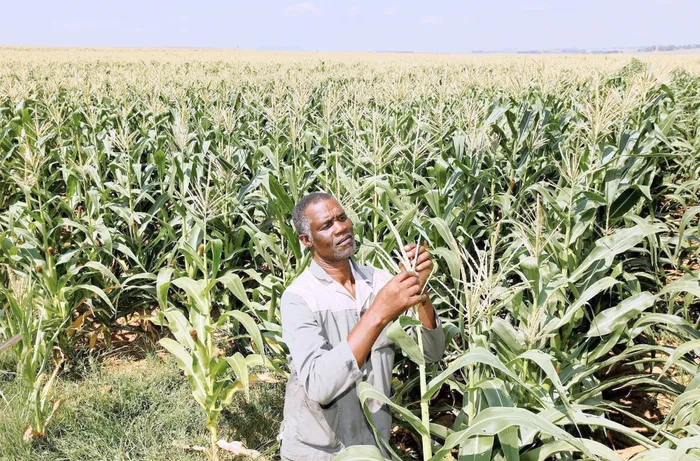
Maize farmer Koos Mthimklulu inspects his crop at his farm in Senekal, in the eastern Free State. African News Agency (ANA). Maize farmer Koos Mthimklulu inspects his crop at his farm in Senekal, in the eastern Free State. African News Agency (ANA).
JOHANNESBURG – South Africa could be forced to import maize at exorbitant prices if drought continues to ravage two of the country's best-producing regions.
There are also fears that this could lead to food (price) inflation and that the country's economic growth could be negatively affected as a result.
Maize production was at a critical level in the maize-producing provinces of North West and Free State, with virtually no crop planted and the optimum planting date having passed.
The two regions produce about 72percent of the total white maize harvest in the country, according to agricultural economist Fanie Brink.
However, he said there was no indication of the number of hectares already planted or that could still be planted.
“This means that maize will have to be imported at much higher import parity prices, which will mainly be determined by the changes in international maize prices and the exchange rate,” said Brink.
“As a result, these conditions may have a very negative impact on the economic growth rate for the second and third quarters in 2019 compared with the same quarters last year, as well as the inflation rate.”
He said the average crop yield for this season could be lower than three tons per hectare.
Brink said if 2million hectares would be planted this season, that would mean a total crop of only 6million tons, but if only 1.5million ha would be planted, the total crop could be as low as 4.5million tons.
“According to these scenarios, the estimated 3.3million tons of maize carryover stocks in the country for the new marketing year starting May 1, 2019, will not be enough for the country’s total demand of between 10 and 11million tons and (of) our neighbouring countries Namibia, Botswana, Swaziland and Lesotho.”
AgriSA deputy executive director Christo van der Rheede said the lobby group was quite concerned about the development. “Many of the farmers had a terrible drought in 2015 and 2016. They are still recovering from that drought. On top of that the maize price declined due to an oversupply in the US,” he said.
“Farmers struggled with a lot of debt, due to the low price of maize. This year they are again faced with drought. We suspect many farmers will not be able to sustain themselves and we are very concerned about that.”
Van der Rheede said AgriSA would call on the government and the banks to assist farmers where they can.
“They must not be too harsh on them if they cannot pay their debt, because they use debt as an instrument to produce food for the country. The government must perhaps assist with a subsidy.”
African Farmers Association of South Africa president Dr Vuyo Mahlati said this was a big issue for small-scale and emerging farmers.
She said they had devised a three-pronged approach to address the issue - nudging the government to act; introducing the concept of crop insurance and embracing proactive approaches to climate change.
“In the beginning we were shocked, but now it's become very clear that climate change is a reality. Small-scale farmers and emerging farmers are struggling already,” said Mahlati.
Absa Agribusiness senior agricultural economist Wessel Lemmer said if farmers could plant about 1.3million ha, like they did in the 2015/16 season, and achieve crop yield of 4 tons per ha, the country may have to import 2million tons of maize.
